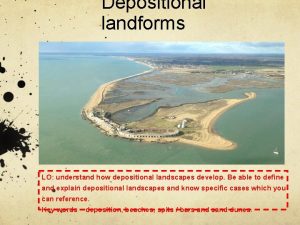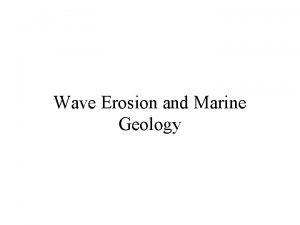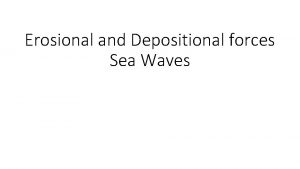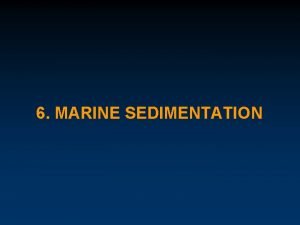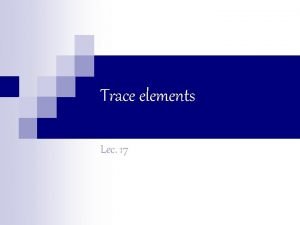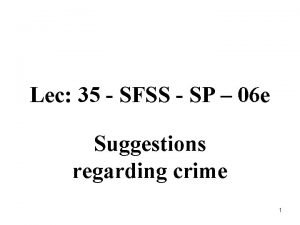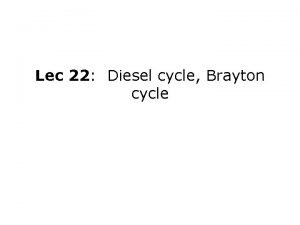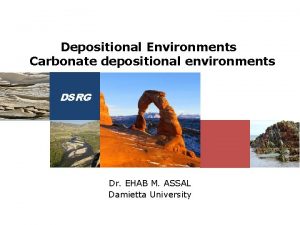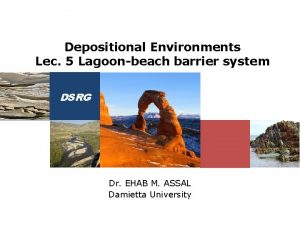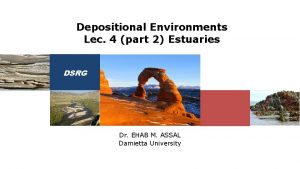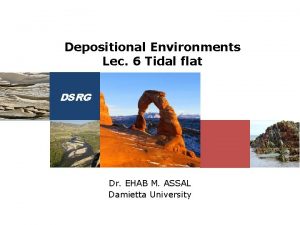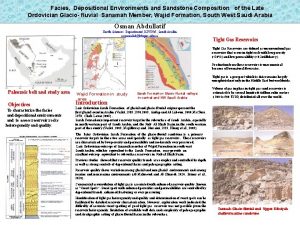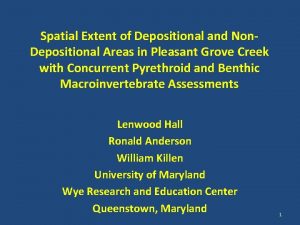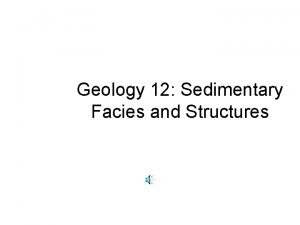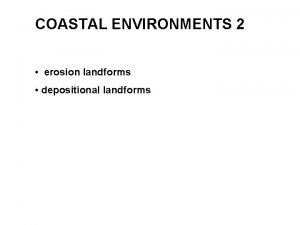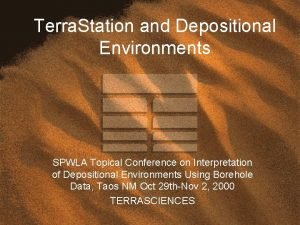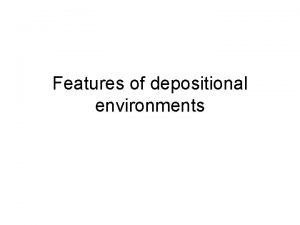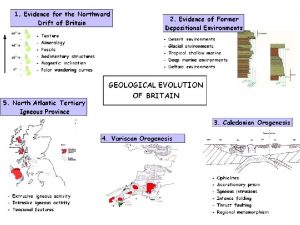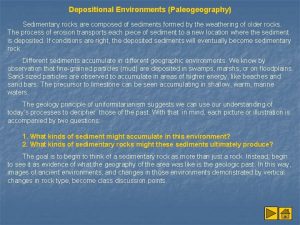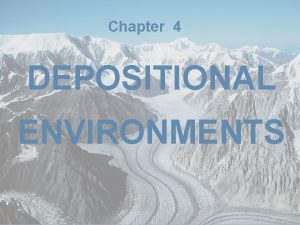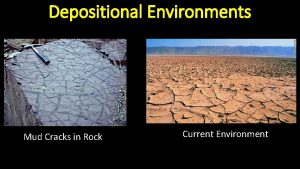Depositional Environments Lec 1 Facies Analysis DSRG Dr

























- Slides: 25

Depositional Environments Lec. 1 Facies Analysis DSRG Dr. EHAB M. ASSAL Damietta University ehab. assal@du. eg

Introduction Depositional Environments, Facies Models and Paleogeograpy Geologic History in Three Dimensions DSRG G 336

Sedimentology! Geology (Sedimentology) is not an exact scince – it is an interpretive science. Do not be afraid to make an interpretation. Remember though that interpretations evolve and change as more data comes to the table; do not be afraid to adapt to those changes George Pemberton DSRG G 336

Introduction v Sedimentology is the study of the processes of formation, transport and deposition of material that accumulates as sediment in continental and marine environments and eventually forms sedimentary rocks. v Stratigraphy is the study of rocks to determine the order and timing of events in Earth history: it provides the time frame that allows us to interpret sedimentary rocks in terms of dynamic evolving environments. v The stratigraphic record of sedimentary rocks is the fundamental database for understanding the evolution of life, plate tectonics through time and global climate change. DSRG G 336

Introduction v The nature of sedimentary material is very varied in origin, size, shape and composition. v Particles such as grains and pebbles may be derived from the erosion of older rocks or directly ejected from volcanoes. v Organisms form a very important source of material, ranging from microbial filaments encrusted with calcium carbonate to whole or broken shells, coral reefs, bones and plant debris. v Direct precipitation of minerals from solution in water also contributes to sediments in some situations. DSRG G 336

Weathering →Erosion → Deposition Mountain/rocks are broken down Weathering Small pieces of rock collectively called: Sediments are transported by air, water and ice Erosion Sediments are dumped in a low lying area (ocean/sea) Deposition Low lying area in ocean & sea where sediments end up is called a Layer after layer is deposited due to the weight, the ocean floor sinks and more space is made Stratigraphy D Basin Due to the pressure, the sediments become compressed and hard A rock is born DSRG G 336

Depositional Environments DSRG G 336

Depositional Environments glacial • Continental • Glacial lakes aeolian • Fluvial • Deserts • Shallow and marginal marine • Deltaic • Linear shorelines (Barrier, non-Barrier) • Estuaries • Deep marine • Offshore (continental slope) • Deep marine (basin floor) 9 DSRG G 336

Depositional Environments v Sediments accumulate in some environment of deposition or depositional environments v These areas receive net deposition v Erosion may occur, but deposition dominates v Features of these depositional environments are preserved in the rock record v Examples: § Sediment texture § Sedimentary structures (formed by processes in the environment) § Fossils of organisms that lived in the environment Ancient environments can be reconstructed from the clues that are preserved in the sedimentary rocks DSRG G 336

Sedimentary Environments & Facies v Describing the facies of a body of sediment involves documenting all the characteristics of its lithology, texture, sedimentary structures and fossil content that can aid in determining the processes of formation. floodplain channel levee v By recognizing associations of facies it is possible to establish the combinations of processes that were dominant; the characteristics of a depositional environment are determined by the processes that are present, and hence there is a link between facies associations and environments of deposition. DSRG G 336

Facies v The definition of facies was introduced by Gressly (1838) and summarized by Middleton (1973). “A rock facies is a body of rock with specified characteristics” or as “a particular combination of lithology, structural and textural attributes that defines features different from other rock bodies”. v It may be a single bed or a group of multiple beds, it should be a distinctive rock that formed under certain conditions of sedimentation, reflecting a particular process, set of conditions or environment. DSRG G 336

Facies v All the properties of a body of rock that allow us to differentiate it from those above, below or laterally adjacent to it v When sedimentary rocks can be handled at outcrop or in cores , a facies may be defined on the basis of § § § § DSRG Color bedding Lithology – rock type, including color, etc. Composition – mineral content Texture – grain size, sorting, roundness Sedimentary structures Fossils G 336

Facies v A word facies is used primarily in descriptive sense. § A term biofacies is used when the biological content is significant. § A lithofacies is more appropriate when fossils is absent or not significant and emphasize is on the physical and chemical characteristics. § A microfacies is used to describe features from thin sections. v in more genetic sense (indicate a process by which the rock is formed) § turbidite facies for inferred deposits by turbidity currents. v in an environmental sense in which a rock or a suite of rocks is thought to have formed. § Fluvial facies or shelf facies DSRG G 336

Facies v as tectofacies ‘postorogenic facies’ or ‘molasse facies’ v Facies are the products of depositional environments v Examples: § § DSRG Planar laminated fine quartz arenite facies Bioturbated, poorly sorted muddy skeletal limestone facies Cross-stratified arkosic conglomerate facies Stromatoporoid-tabulate coral reef facies G 336

Facies Associations & Sequences v Individual facies vary in their interpretative value. § A rootlet bed and coal sea implies that the depositional surface was very close to, or above water level. A rootled bed cannot be said to have formed in any one environment. It may have formed in backswamp, or an alluvial fan, or a river levee or at a shoreline. Thus we have to recognize the interpretative limitations of an individual bed § A current-rippled sandstone implies that deposition took place in the lower part of the lower flow regime from a current that flowed in a particular direction. It give a litte information regarding salinity, depth or environment. A knowledge of the context of a facies is essential before proposing an environmental interpretation. § a gradded sandstone bed found interbedded with quietwater pelagic limestones and mudstones would be interpreted differently from an identical graded sandstone interbedded with wave rippled sandstones clearly deposited in agitated shallow water. DSRG G 336

Facies Association & Architecture v Definition of facies on small scale, e. g. , § minor changes in proportion of silt and mud. § relative abundance and diversity of fossils. § minor differences in the style of lamination, results in a facies scheme where the descriptive differences outstrip our ability to interpret the differences. Therefore, it is useful to combine closely related facies into facies associations “groups of facies genetically related to one another and which have some environmental significance” (Collinsoin, 1969). v The larger scale facies associations have also been termed architectural elements (Allen, 1983), implying that they are the building blocks of the various depositional system. (e. g. , a river channel) v The concept of architectural elements also emphasizes the three dimensional geometry of the facies associations. DSRG G 336

Facies Sequence (succession) v In some succession the facies may lie in a preferred order with vertical transitions. Thus , there is a predictability about such successions that enables us to anticipate within known limits what we shall encounter as we move upwards or downwards through the successions. v A facies sequence (succession; sensu R. G. Walker, 1990) “is a series of facies which pass gradually from one into the other”. v Most facies sequences are bounded at top and bottom by a sharp or erosive junction, or by a hiatus in deposition indicated by a bioturbated horizon, a rootled bed, hardground or early diagenesis. v The importance of facies sequences has long been recognized, at least since Wather’s Law of Facies (1894) DSRG G 336

Walther’s Law v Only works where there are no unconformities v Only facies that were laterally adjacent during deposition (result of laterally adjacent environments) can be stacked vertically v Vertical arrangement of facies gives us information on § Distribution of environments § How environments migrated through space and time v Used as a basis to build facies maps or paleogeographic maps v Accurate time correlation of facies is essential v Time lines provide framework for correlation § Bio-events § Volcanic ashes § Other thin, unique lithologies or marker beds DSRG G 336

Walther’s Law • Beach (foreshore, backshore, dunes) – low angle/horizontal bedding • Shoreface (above Fairweather wave base) – dunes, cross bedding • Offshore transition (above Storm wave base) – hummocky cross stratification DSRG G 336

Facies Model v A facies model can be defined as a general summary of a given depositional system v Constructed from modern environments and ancient rocks v Serves as a § Norm for comparison § Framework for further observation § Predictor of sedimentation patterns in new geological situations § An integrated basis for interpretation for the system that it represents DSRG G 336

Facies Pattern v Groups of facies commonly show patterns: v Proximal Facies (near the source) tend to be coarse grained v Distal Facies (far from source) tend to be finer grained v This pattern is displayed upstream and down in rivers and onshore to offshore in coastal areas v Facies are arranged according to distribution of depositional environments DSRG G 336

Facies Migration v Facies migrate through space and time v Migration is in response to environmental factors § Sediment supply § Sea level change § Subsidence v Facies become stacked during migration v A single facies is likely to be different ages in different locations DSRG G 336

The Spectrum of Environments & Facies v Every depositional environment has a unique combination of processes, and the products of these processes, the sedimentary rocks, will be a similarly unique assemblage. For convenience of description and interpretation, depositional environments are classified as, for example, a delta, an estuary or a shoreline, and subcategories of each are established, such as waved-dominated, tidedominated and river-dominated deltas DSRG G 336

Paralic Environments DSRG G 336

DSRG www. mans. edu. eg/Fac. Sci. D
 Facies etilica
Facies etilica Depositional landforms
Depositional landforms Breaking down of rocks
Breaking down of rocks Erosional vs depositional
Erosional vs depositional Depositional feature of sea waves
Depositional feature of sea waves Depositional environment definition
Depositional environment definition Lec scoreboard
Lec scoreboard 11th chemistry thermodynamics lec 13
11th chemistry thermodynamics lec 13 Lec ditto
Lec ditto Scoreboarding computer architecture
Scoreboarding computer architecture Componentes del lec
Componentes del lec 11th chemistry thermodynamics lec 10
11th chemistry thermodynamics lec 10 Elements lec
Elements lec August lec 250
August lec 250 Lec 16
Lec 16 Lec 1
Lec 1 Apelacin
Apelacin Lec
Lec 132000 lec
132000 lec Ir.ac.kashanu.register://h
Ir.ac.kashanu.register://h Tipos de lec
Tipos de lec Sekisui s-lec america llc
Sekisui s-lec america llc 416 lec
416 lec Lec
Lec Diesel lec
Diesel lec Lec promotion
Lec promotion

